January 12 - 18, 2014: Issue 145
Pittwater’s Parallel Estuary: The Cowan ‘Creek’
So many residents of Pittwater, relishing in being members of a maritime community, take off for the less crowded waters of Little Pittwater Bay, America’s Bay, Jerusalem Bay, Coal and Candle creek, Looking Glass Bay and Cowan, all recalling long summers of having spent weeks on these bays. To so many it seems natural to seek places that remind us of what Pittwater was like over a century ago.
This week we are fortunate to be running as our Profile of the Week the redoubtable Hon. James Joseph Macken whose favourite ‘escape to’ places are the ridges behind his Coaster’s Retreat home that overlook these splendid waters. When listening to Sir Jim relate the many indigenous places and ‘songlines’ he has walked in this area a shiver goes over the whole skin. You just know he can still see our original custodians out the corner of his eyes during his wanderings through the bush and along the West Head road.
Thus, as part of our summer 2014 celebrations, one for you, Historian of Pittwater, and all of you purists who know where the quiet bays are at!
SCENES AT COWAN (KURING-GAI CHASE) , BROKEN BAY.
(Photos, by Kerry and Co.. George-street, Sydney.)
(See illustrations on this and next page.)
The illustrations of Kuring-Gai Chase give picturesque glimpses of wood and water, of rocky crags and creeping shadows, that steal across hill and valley on a spring afternoon. A national park, a perpetual gift to the people, Kuring-gai Chase is peculiarly the property of North Sydney. The title is a compound of aboriginal and English. The native name, followed by the word "Chase," shows that in the christening of places as well as children-we move forward in a circle.
In opening up new country In Australia, native and English words are generally favored with occasional lapses into "Wild West" descriptive phrase. Not far from one of the streams that branch off Narrabeen Creek you will find "Tumbledown Dick." Whether 'that is Dick's usual condition, or whether some hills near Pittwater poses a broken-down appearance frequently associated with gentlemen of the Dick Swiveller type, is best known to those acquainted with the locality. Coal and Candle Creek and Smith's Creek are both arms of Cowan Creek on its eastern side. Yeoman's Bay is a smaller estuary of the same deep-water inlet-Cowan Creek-which large steamers can navigate for nine miles up from its mouth to Bobbin Rock at within about three miles of the Sydney ten-mile boundary.
As it narrows to a finish, Cowan Creek divides into two parts. The south-westerly stream (described as one of the most charming spots in Kuring-Gai Chase) is called Gibberagong Creek. And here again the white man follows the black man. Gibberagong certainly suggest an alias, and there it is- ‘Cockle Creek’! For this little stream may be called by either name, according to taste. Coming up to the north-east of Cowan Creek is a fairly deep water inlet-Jerusalem Bay.
Kuring-Gai Chase contains about 35,000 acres, a good deal of which is hilly country, and "very abrupt rocky ranges of a general altitude of about 600ft above the sea level." On the map a good idea is gained of its deeply-indented shores, the water cutting it into a curious broken line, and in shape the land looks like a piece of paper, out of which a geological child has been snipping large pieces to take away as scientific samples. Approaching by steamer, and entering Broken Bay, the Upper Hawkesbury River takes a bold sweep to the north-west, the Lower Hawkesbury merging into Cowan Creek, with its deep estuaries. Almost due north and south-from Broken Bay-is the noble sheet of water named by Phillip "Pittwater." after the great statesman; for when he pushed his exploring parties further north and entered Broken Bay, he was much impressed by the beauty of this great inlet, and thinking it "the finest piece of water he had ever seen," decided that he would name it in honor of Pitt. From Newport to Barranjoey is the eastern land boundary of this estuary, and the formation of this tongue of land from Careel Bay ends in a neck which widens into a termination not unlike a flat cobra's head. This is Barranjoey. On the other side of Pittwater is the eastern shore of Kuring-Gai Chase, and passing its wooded promontories, at its northern extremity, you enter the waters of the Hawkesbury River. And here again the Chase is divided into sections, two of which-Cowan and Berowra-are almost divided from each other by Jerusalem Bay. On the other shore the section of Pittwater is indented by Coal and Candle Creek, which nearly cuts it through, to within a short distance of M'Carr's Creek, which falls into the southern extremity of Pittwater. From Wahroonga, Pymble, and Turramurra, there is a track through portion of the section known as Bobbin, by which it is possible to reach Kuring-Gai by land, but by the end of the year much greater facilities will be opened up to the general public who wish to reach this picturesque park. Colah, near Cockle and Cowan Creeks, is said to have a good road, by which the residents of Hornsby can drive to a highpoint of land overlooking Foley's Bay.
The Hawkesbury has often been called the "Australian Rhine." To dedicate to the people for all time its wooded shores, and the sparkling waters which intersect this national park, its bold headlands and shadowy valleys, and all the beauty of form and foliage comprised in Kuring-Gai Chase, would be a fitting ceremony to be performed by the first Governor-General of United Australia.
SCENES AT COWAN (KURING-GAI CHASE), BROKEN BAY. (1900, December 15). Australian Town and Country Journal(NSW : 1870 - 1907), p. 40. Retrieved from http://nla.gov.au/nla.news-article71388002
Please note that we found these same photographs on the Powerhouse Museums fantastic Tyrell Collection on Flickr and have used these. Also see Flagstaff Hill and The Namoi
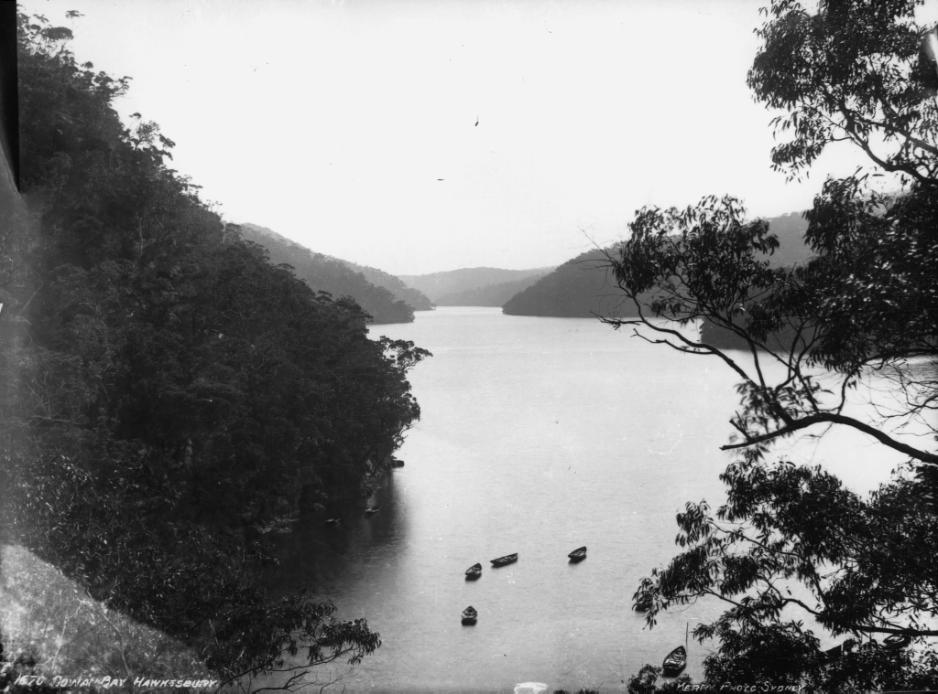
COWAN BAY.
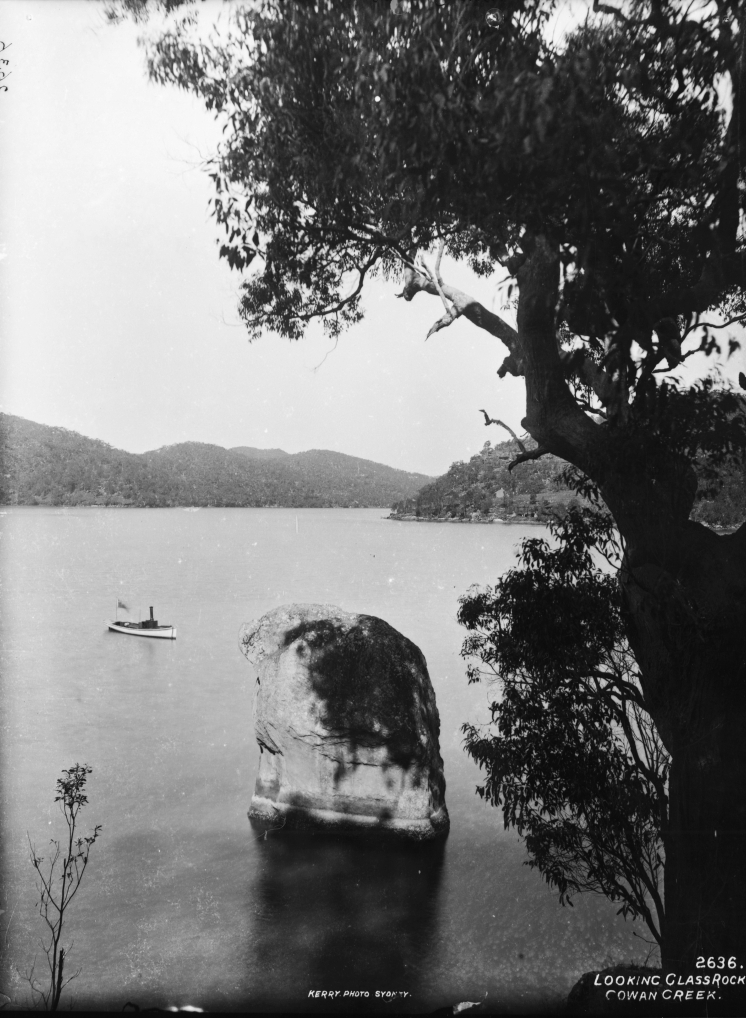
ENTRANCE TO COAL AND CANDLE CREEK, COWAN.
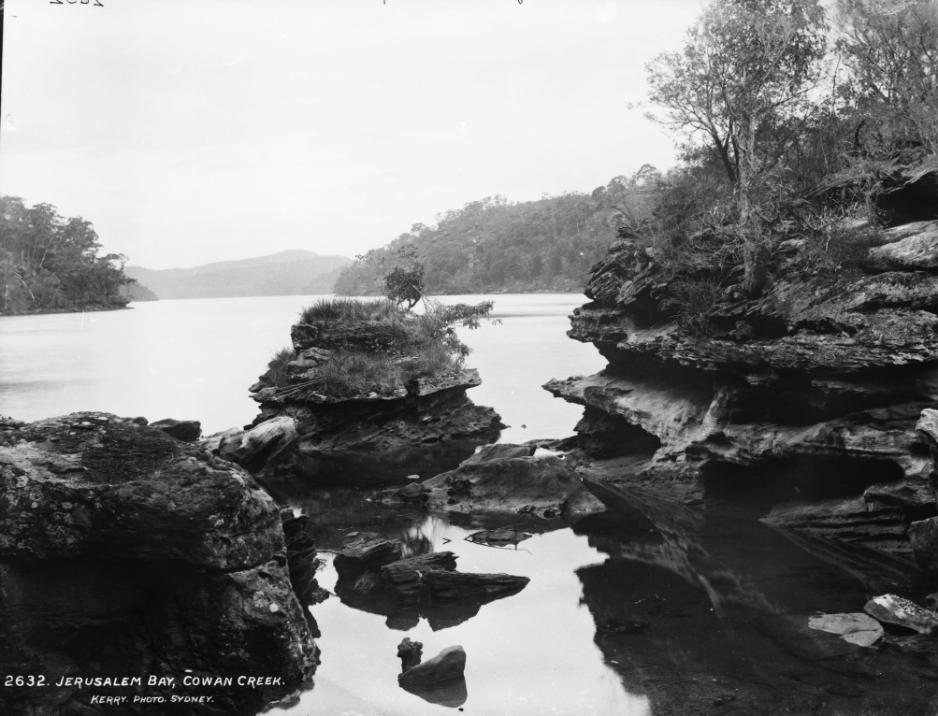
HEAD OF JERUSALEM BAY.
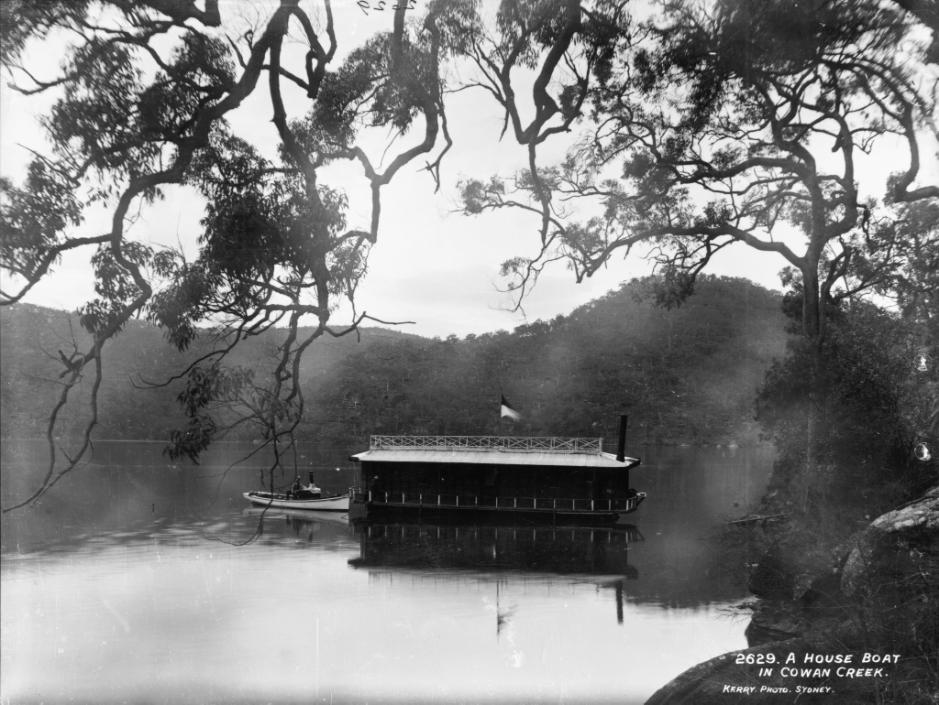
A BAY IN COWAN AND HOUSEBOAT.
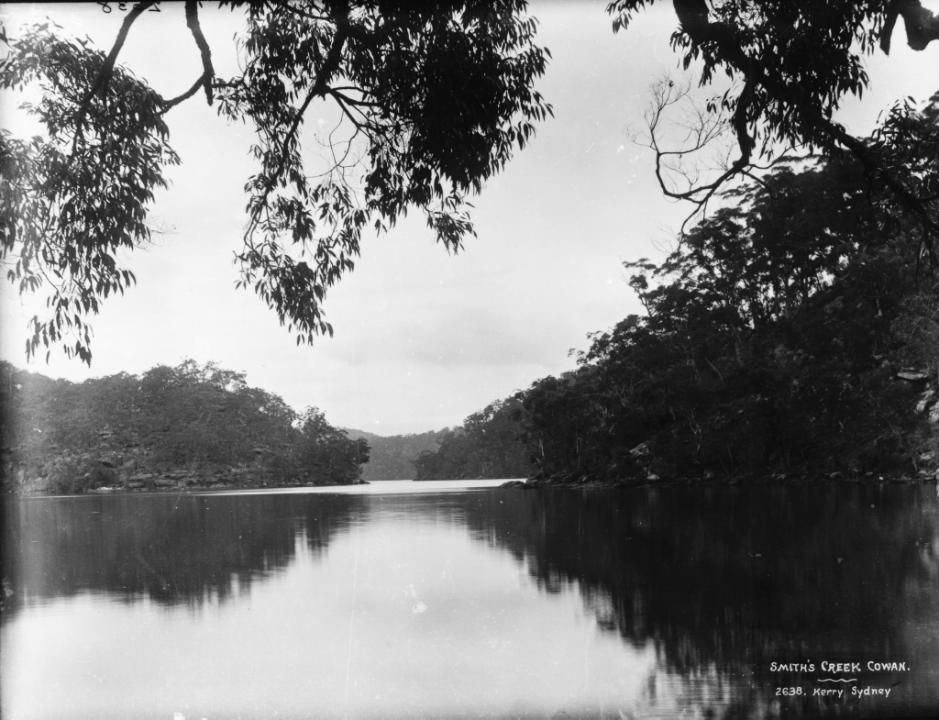
VIEW NEAR MOUTH OF SMITH'S CREEK.
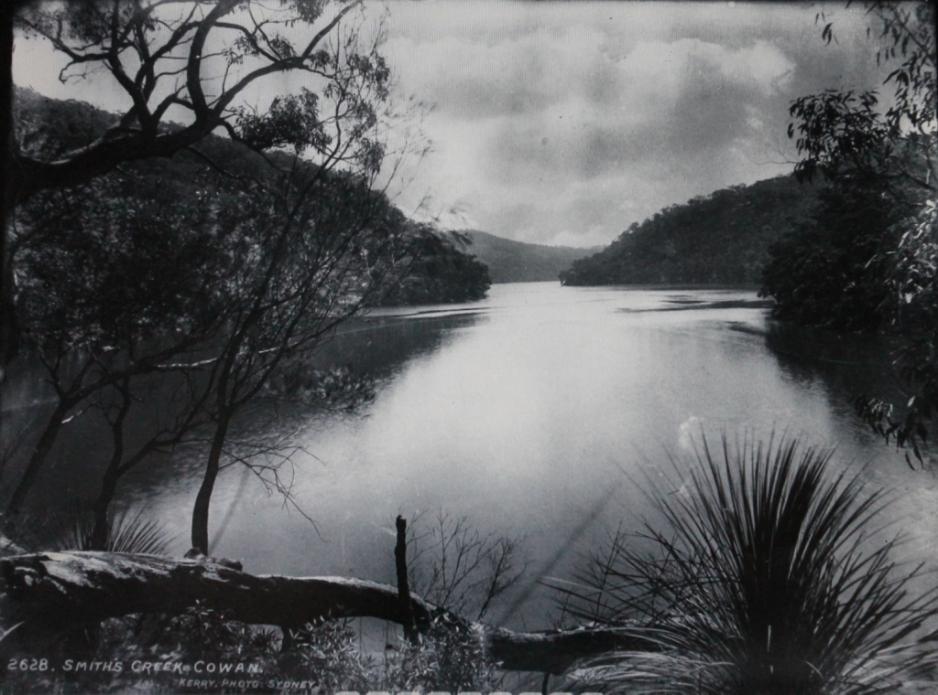
BAYVIEW, SMITH'S CREEK.
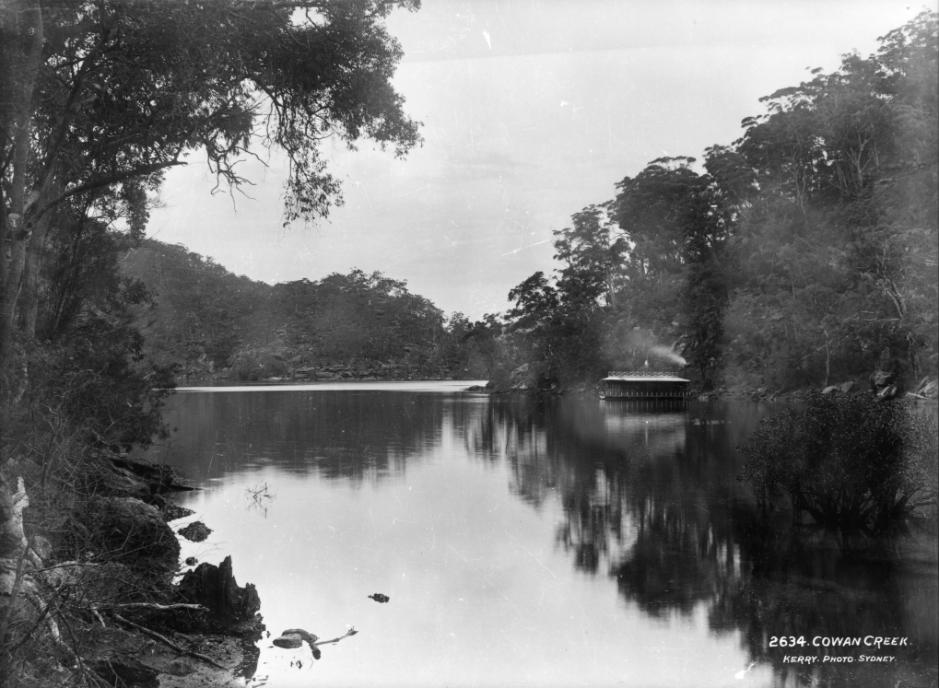
LONG BAY, COWAN.
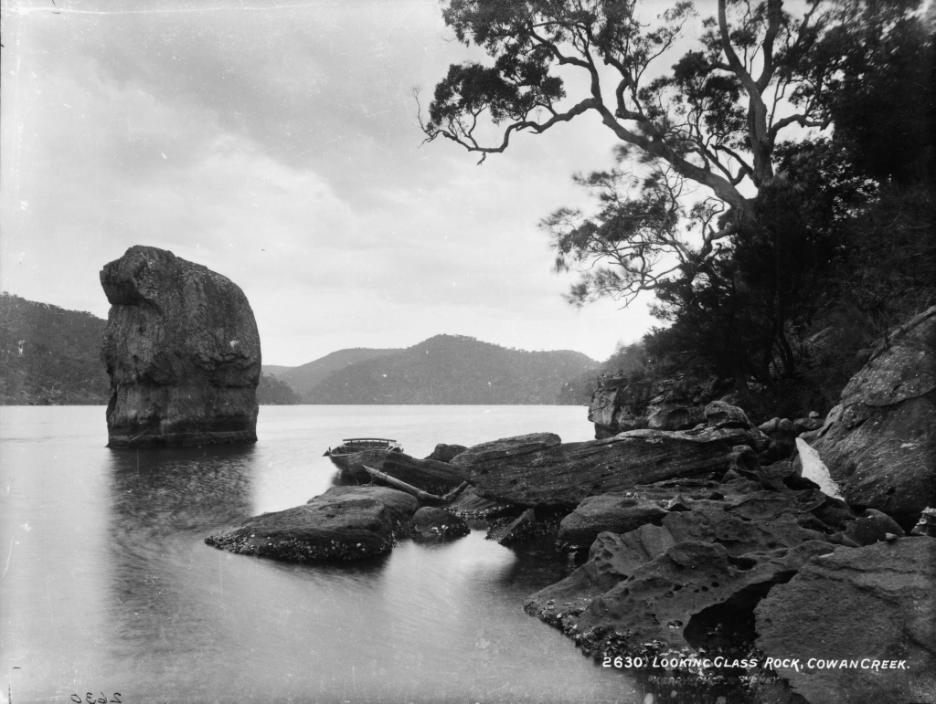
LOOKING-GLASS ROCK, COWAN CREEK.
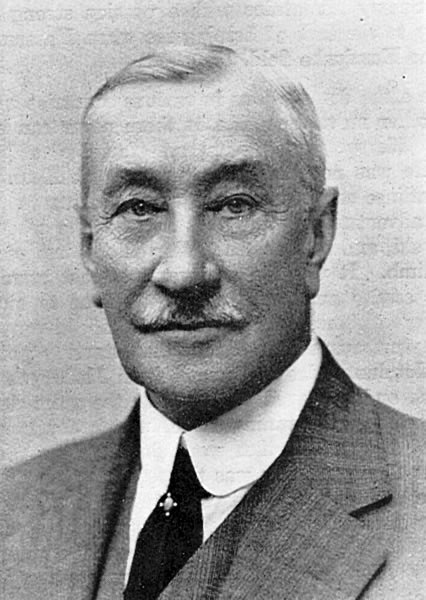 The
Tyrrell Collection consists of 7903 glass plate negatives from the studios of
Charles Kerry (1857-1928) and Henry King (1855-1923) who had two of
Sydney's principal photographic studios in the late 1800s and early 1900s. The
collection was bought by the Sydney bookseller, James R. Tyrrell, in 1929 for a
proposed floating ethnographic museum moored in Sydney Harbour. Although the
museum never eventuated, Tyrrell kept the collection intact, eventually selling
it in 1980 to Australian Consolidated Press who donated it to the museum in
1985.
The
Tyrrell Collection consists of 7903 glass plate negatives from the studios of
Charles Kerry (1857-1928) and Henry King (1855-1923) who had two of
Sydney's principal photographic studios in the late 1800s and early 1900s. The
collection was bought by the Sydney bookseller, James R. Tyrrell, in 1929 for a
proposed floating ethnographic museum moored in Sydney Harbour. Although the
museum never eventuated, Tyrrell kept the collection intact, eventually selling
it in 1980 to Australian Consolidated Press who donated it to the museum in
1985.
All the photographs in the collection were intended for sale: first as prints, and later as postcards when the craze for collecting them began. Both Kerry and King also exhibited at international and intercolonial exhibitions.
Charles Kerry began his career as a photographer in about 1875, working for the Sydney portrait photographer, A.H. Lamartiniere, who absconded with all the money. By 1884, Kerry had taken over the business and had his studio at 308 George Street, Sydney. In 1890 he was appointed official photographer to the Governor of New South Wales, Lord Carrington. In addition to his portrait work, Kerry took on a number of government commissions, including travelling through New South Wales to photograph Aboriginal peoples, their camps and corroborees and taking detailed interior views of Jenolan Caves. Kerry's work was greatly facilitated by the invention of the dry-plate process in Europe in 1878. Where once photographs had to be developed on the spot, now they could be taken and developed later in the studio. Kerry's photographs of New South Wales were exhibited at the 1893 Chicago International Exhibition. By 1900 he supplied the bulk of all images to local newspapers. In 1913, Kerry retired to take up mining. Although his nephew took over the business, increased competition and changing tastes meant that Kerry & Co closed in 1917. He died at his home at Neutral Bay in 1928 shortly after returning from a trip to the Barrier Reef.
As of April 2008, many of the Tyrrell images are being progressively released to the Commons on Flickr. Everyone is encouraged to go on a journey of Australian places and events and to help name what is happening where and when.
Photo of Charles Kerry from 1928 Ski Year Book (he was also an avid snow sports promoter) See HERE
A Christmas Day at Cowan Creek, Hawkesbury River.
(Written for the "Town and Country Journal.")
"For a successful fishing outing," declared Daylesford, "you must be on the water by peep o' day."
The youth, who was anxiously watching the horizon for the moon-rise to enable him to commence a possum hunt, concurred very heartily. The languid man, with his pipe drawing particularly well, and his hip jammed snugly in a heap of ferns, approved of early rising on hygienic principles, but thought fish that hadn't the decency to wait until noon to be caught would in all probability be lean, highly strung creatures unworthy of angling. But when the youth returned after three hours fruitless stalking of excrescences on gnarled trees, and his lust for sport merely aggravated, his entreaties, added to the supplications of the man who had brought a large number of faded prawns in a stained parcel, were irresistible, and a a.m. start was agreed upon. Even the languid man was aroused to the extent of relating, well on towards midnight, all he had ever thought or read about the ways of awakening at any given hour. The languid man has a tenacious memory-as a matter of fact, he Is too indolent to forget and if it were not for the pleasing circumstance that he has never read or heard of anything of interest, his remarks might keep one awake.
"Goo' ni*." The bait-a succulent prawn, with his feet neatly curled and his whiskers skilfully poised-is adjusted; the line is barely cast before there is a 'tug-tug, and there is a great fish swirling in wide silvery sweeps. We brace our feet against the gunwale, and take a turn of the line round our wrist. The line fairly hums as the great fish strains and swirls in steadily-increasing curves. We catch a glimpse of his bristling fins; we see his widespread eyes agleam with fury. Thunder! He is dragging us over the side. The gunwale is bending under the strain like elastic. The perspiration stands in globules on our forehead; our hair stands on end- over the side, into the green depths.
"Come along-, boys; it's half-past three." The artist, candle in hand, stands, by the bunk. Through the open doorway there is a glimpse of stars. The bed is so cosy; the earth seems so still. Surely, it is nothing short of madness to think about getting up at such a time as this! But the youth, already has his pockets abulge with lines, and exudes an odor of very dead prawns, as he divides his time between boiling the billy and filling cartridges from a little mound of powder, so close to the blaze that the languid man is fairly awakened at the sight. The horse, with ferns and dead leaves in its mane, and deep distrustful eyes blinking at the light, submits to be harnessed in a sort of dream, and abstractedly backs into position between the shafts.
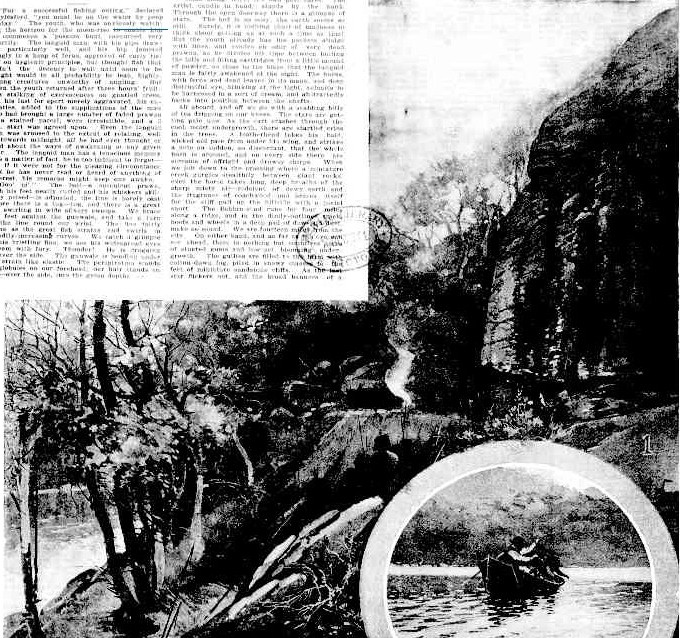 All
aboard, and off we go with a scalding billy of tea dripping on our knees. The
stars are getting pale now. As the cart crashes through the cool, moist
undergrowth, there are startled cries in the trees. A leatherhead takes his
bald, wicked old pate from under his wing, and strikes a note so sudden, so
discordant, that the whole bush is aroused, and on every side there are screams
of affright and drowsy chirps. When we jolt down to the crossing where a
miniature creek gurgles stealthily between giant rocks, even the horse takes
long, deep breaths of the sharp misty air-redolent of dewy earth and the
fragrance of coachwood-and braces itself for the stiff pull up the hillside with
a jovial snort. The Bobbin-road runs for four miles along a ridge, and in the
dimly-outlinend tracks, hoofs and wheels in a deep pad of dewey dust make no
sound. We are fourteen miles from the city. On either hand, and as far as the eye can see
ahead, there is nothing but countless acres of stunted gums and low-set blooming
under growth. The gullies are filled to the brim with cotton-down fog, piled in
snowy mass to the feet of miniature sandstone cliffs. As the last star flickers
out, and the broad banners of a magnificent day are spread aloft, even the
artist is satisfied with the color scheme. We must needs pull up here. This is
glorious, but just over the hill there, we could-by jingo! we've forgotten to
drink the tea. It's black and bitter, but nobody minds. Across the narrow track
enterprising spiders have spun webs, and planned magnificent ambuscades, into
which have fallen nothing more substantial than beads of dew that scintillate
like diamonds. The horse cleaves through them ruthlessly, adding at every few
yards to the gleaming tiara on forelock and ears, while spiders in vesture all
too brilliant for their gruesome avocation wave despairing legs in eager effort
to repair the shattered nets.
All
aboard, and off we go with a scalding billy of tea dripping on our knees. The
stars are getting pale now. As the cart crashes through the cool, moist
undergrowth, there are startled cries in the trees. A leatherhead takes his
bald, wicked old pate from under his wing, and strikes a note so sudden, so
discordant, that the whole bush is aroused, and on every side there are screams
of affright and drowsy chirps. When we jolt down to the crossing where a
miniature creek gurgles stealthily between giant rocks, even the horse takes
long, deep breaths of the sharp misty air-redolent of dewy earth and the
fragrance of coachwood-and braces itself for the stiff pull up the hillside with
a jovial snort. The Bobbin-road runs for four miles along a ridge, and in the
dimly-outlinend tracks, hoofs and wheels in a deep pad of dewey dust make no
sound. We are fourteen miles from the city. On either hand, and as far as the eye can see
ahead, there is nothing but countless acres of stunted gums and low-set blooming
under growth. The gullies are filled to the brim with cotton-down fog, piled in
snowy mass to the feet of miniature sandstone cliffs. As the last star flickers
out, and the broad banners of a magnificent day are spread aloft, even the
artist is satisfied with the color scheme. We must needs pull up here. This is
glorious, but just over the hill there, we could-by jingo! we've forgotten to
drink the tea. It's black and bitter, but nobody minds. Across the narrow track
enterprising spiders have spun webs, and planned magnificent ambuscades, into
which have fallen nothing more substantial than beads of dew that scintillate
like diamonds. The horse cleaves through them ruthlessly, adding at every few
yards to the gleaming tiara on forelock and ears, while spiders in vesture all
too brilliant for their gruesome avocation wave despairing legs in eager effort
to repair the shattered nets.
Suddenly, away down through the trees, there is a glimpse of dark, smooth water, with little clouds of mist stirring sluggishly in the morning air. To reach it we must go down a zigzag path, which makes a descent of some 500 or 600 feet in half a down grades. About 100ft above this bay we halt to put up the horse in an enclosure provided for the purpose. Then, by clambering down some steps and falling down a great many more, we arrive abruptly on the roof of the boatman's shed. To awaken him after this procedure is not difficult, and, despite certain opposition on the part of his dog, whose body is adorned with spots in lieu of hair, and which wanted to take samples of our persons for future reference or bait, we are speedily afloat. The languid man, with great adroitness, secured a seat as far from the centres of activity as possible, so we gave him the prawns to mind. In half an hour we are in an ideal spot. On one side dark, beetling cliffs stand straight up from the water's edge, on the other the land, shelves down in a grassy slope to the oyster-clad shingle. The languid man declared, almost with animation, that someday he would work out the point as to whether the three lines with which the youth had determined to fish or the kellick stone had reached bottom first; but it is feared that the matter is too much akin to the passage of thought to be cleared up.
"Ah! Shark! Got him! No! Yes! Ah!" Everybody tries to get out of the road. Everybody knocks over something. The youth, with nerves strung to snapping point, lands a fish. The artist, whose camera has cramps or something in its stomach, casts but a single glance at the flapping creature, and says, "Pshaw!" with great vehemence. The languid man, who is cherishing a great longing to lose the prawns, says, "Never mind, we'll use it for bait." And so, and so, and so, until, after three hours fishing in six different places, the artist, who has laid aside his tools, and is dispensing thick junks of bread and jam, orders us ashore for breakfast. And as the potted things are opened up, and as we sneeze and choke and weep in the smoke that curls through the widespread limbs and dense foliage of the great trees that stand precariously on the water's edge, the youth is not the youngest of us all. The languid man in an abortive cast throws the tea into the fringe of the fire, and gathers and puts it into the pot with such unprecedented haste that nobody has time to stop him. But nectar could not be sweeter. Possibly it is the extraordinary number of sugar ants and other inquisitive insects in it that makes billy tea so good to taste. Anyhow, to the picnicker rejuvenescent nothing comes amiss.
Fisho till noon, and then, under the shaded side of the towering shore, we lazily make for the Bobbin Cave. Out in the bay the water is stirred in little patches by the whispering breaths of a north-easter, and glitters in broad bands of sparkling silver. But under the shaded bank it is unruffled as a mirror. As we gaze down into its limpid depths, we see fine black bream lazily nosing around the stones on the bottom, and every now and then we pass a place where the trees and rocks on the shore and to the very tops of the hills are reflected so clearly that one becomes really startled to see a school of fish disporting in the branches and among the ferns and grass.
Cowan is famed for its caves. In some of them at present there are regular habitations of fisher folk. We passed one in which all the signs of permanent residence are evident. Elderly fowls strut and preen their feathers on the piles of decomposed shells; chickens race after grasshoppers on the grassy slopes, and at the mouth of a cunning little crevice a hen proclaimed to all the world that bright Christmas day that she had done her duty. In a gin case under a shelving rock a colony of bees are housed. For a foraging ground they have broad acres of all the flora that the heart of bee can desire, and for their hoardings there is no doubt a market in the holiday parties that throng the gaily painted houseboats moored in the deep, green bays. Bobbin Cave is a citadel at the mouth of Gibberabong Creek, and it was only by virtue of certain committal statements the languid man had made that he could be induced to consent to our climbing the steep approach to it. Hedged in by rocks bold and perpendicular as masonry, this cavern fulfils even the ideal of the robber cave of boyhood dreams. Its walls are blackened by the smoke of countless ages, and when we stretched ourselves on the smooth floor to digest a great deal more than was safe for any of us to have eaten, we all fell wondering; what sort of scene had. been enacted there on Christmas Day a hundred .years ago. This fastness at the head of the great water, inaccessible from behind and above (where, indeed, on the broad flat rocks there are to this day to be found, graved deep in the surface, many carvings and symbols of a race that is no more) ; with its steep approach, with its unfailing limpid spring; with its deep water fishing and broad expanse of shallows, where tons of luscious shellfish lie easy to the hand-this, surely, was a mighty place. We see the tribesmen gathered here to put their weapons in order for battle with the tribes across the hills, where the low moan of the ocean can be heard on the Barrenjoey sands. That was a favorite battleground, and now and again, when the sea in fury tries to drag back into its depths the barrier it has itself piled up between the Barrenjoey and the mainland, grim evidences of warfare, In the shape of cloven skulls and bones, are laid bare. Or perhaps this was the haven to which the remnant of a stricken army would painfully creep to heal their hurts and plot revenge.
In such a spot as this may have sat in conclave many chiefs, with intertribal feuds buried in face of common dread of the winged terrors arisen from the sea, and discussed and marvelled at the dread language of smoke and death that the white foes spoke.
The languid man said such things ought not to be discussed on Christmas Days. It made him creepy to think of the hordes of spirits wandering about thrusting spears through intangible enemies and hurling spectral boomerangs at palaeontological spooks. He was rather inclined to think that the aborigine would most likely have spent his Christmas here in strict accordance with barbarian ideas of a season of festival. The chances were that the tribesmen, in their forcible way, would have induced the gins and the piccaninnies to hasten to the cockle patch down yonder to fill their dilly-bags with mussels and so on, while the warriors made off across country to look for shoals of mullet. These fish, went on-the languid man, came into the river, mouths, etc.,.. to spawn in the shallows, and of course the blacks could take it nice and easy, and wait for them to swim past places at which spearing could be performed to advantage. Of course, nobody wants to say that the warriors were entranced with the sport, or anything like that, but no doubt they would get about wearied to death by the end of the year of such beastly rough work as wallaby hunting, and they would, no doubt, be regularly nauseated with possum done in the skin, and cooked by women without cookery books. So, of course, they'd get as many fine fat mullet as possible, bring them home, and let the gins cook them here. Then, when all hands were so full that they couldn't eat anymore, the sensible savages would go to sleep and have a rest from the infernal racket of cicadas.
And all the time the artist, with his mind on those Christmas days at home when, seated in a box over a hole in the thick ice, he would sit and spear fish in the clear depths, spoke not. His camera had played him false. The spring upon which he placed his sole reliance was supine as a boiled feather. And so he refused to stock his mental pantry with any jars of romance done up in aboriginal labels. Romance that, you could not get at with a camera is something that does not appeal to his modern soul, and so, with his feet back once more on his native heath of asphalt pavement and wood-blocked road, he refers to Cowan, not as the gem of natural beauty amid the home of old romance, but as "the place where my camera broke down”.
Cowan Creek, Hawkesbury River sketches: 1-In the Days of the Aborigines. 2.-The Big Cave. 3-A Fishing Party. (See letterpress on previous page.) A Christmas Day at Cowan Creek, Hawkesbury River. (1901, December 14). Australian Town and Country Journal (NSW : 1870 - 1907), p. 24. Retrieved from http://nla.gov.au/nla.news-article71475710
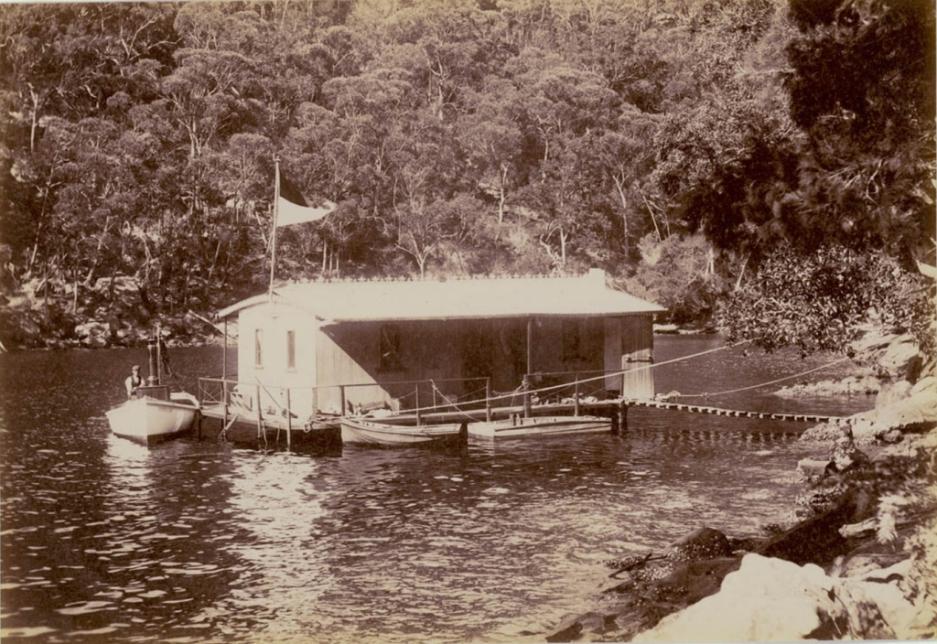
Trustees oil launch and Houseboat, Kuring-gai Bay, 1899. Image No.: a116504h, courtesy State Library of NSW
COWAN CREEK. The beautiful Cowan Creek is full of picnic, house-boat, and camping parties. The many caves along the river have been great attractions When the Government fixes up those caves with floors fireplaces and c. , they will be a great boon to holidaymakers. COWAN CREEK. (1898, December 27). The Sydney Morning Herald (NSW : 1842 - 1954), p. 5. Retrieved from http://nla.gov.au/nla.news-article14192488
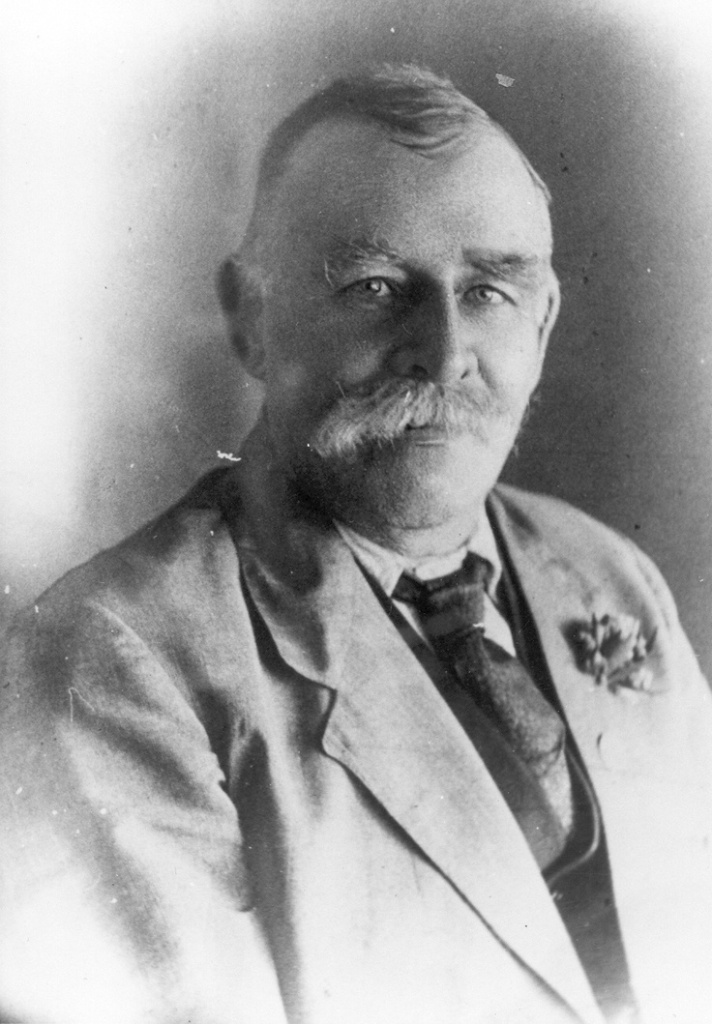 E. WINDYBANK, PIONEER OF COWAN
E. WINDYBANK, PIONEER OF COWAN
Died last week at Patonga Beach, the pioneer of what is stupidly called Cowan Creek. The word 'creek’ suggests to most of us a small water-course, across which one might throw a biscuit, whereas, it is m reality a series of very beautiful sounds,. 50 to 60 feet deep, with no shoals or sandbanks. Each sound is girt about with everlasting hills, wooded to the water's edge. The Windybanks have now numerous cottages and houseboats, but 45 years ago, Windybank built his first boat, carrying the timber on his back across the mountains. He amused himself, between his rowing to Hawkesbury on a raft, buying old steamers and dismantling them —even to the boilers, unaided — by writing doggerel verse, and painting pictures —hung on the line of his own Royal Academy. A houseboat and a motor launch on the Cowan Sounds provide an ideal holiday — four miles from Broken Bay, five from Hawkesbury, and three from Bobbin Head. E. WINDYBANK, PIONEER OF COWAN. (1928, February 19).Sunday Times (Sydney, NSW : 1895 - 1930), p. 47. Retrieved from http://nla.gov.au/nla.news-article122807989
FISHING NOTES (By 'GLAUCUS.')
I HAVE just had an interesting stay at Cowan Creek on one of the houseboats in that popular resort, Mr. S. Baldock having kindly placed his neat little boat at my disposal. Ned Windybank also assisted to make the trip a pleasant one with his kindly hospitality, so while the city folk were wondering what kind of winter was coming on top of the coastal gales, I was putting In a quiet, healthful stay in the sheltered creek. It is strange that so few people know anything about life on a houseboat. It is such a free and easy life that it should specially appeal to Australians. It is far preferable to camping in a tent, and one can safely take children on to the roomy boats. Mr. Baldock's house on the water is at Coal and Candle Bay, near one of the best grounds for schnapper in the whole of the deep water of Cowan. It has been well planned and constructed, and is very suitable for a small party of half a dozen men. It represents a good many hours of labor by a busy man In his spare time, and when completely finished will be as comfortable a temporary home as one could wish for. It is small, but then it has not been built for a large crowd, and the men who use it are all fond of fishing, and really only require the place for the night. Ned Windybank's fine Fairyland is near, and there is a plentiful supply of water in the creek a hundred yards away. I only succeeded in raising one of the Cowan schnapper, a five pounder, that provided a tasty meal for the family, but there were plenty of small fish in the place. A large skate was the first fish to be grilled. The flaps of a twelve pounder made two excellent meals. The leather-Jackets are very plentiful and are of all colors. They are as razor toothed as ever. The skate tasted like tender lobster, and was a decided success. FISHING NOTES. (1903, June 3). Referee (Sydney, NSW : 1886 - 1939), p. 6. Retrieved from http://nla.gov.au/nla.news-article120664475
The following reports hall from Eastway's: —Mr. Bennett and family have secured the house-boat Dreamland at Cowan Creek for a few -weeks. Mr. Bennett reports 'the fish biting well- near Looking-glass Rock. Jewfish, flathead, large red and black bream keep thefamily well supplied In fish.' Mr. Bennett hails from Turramurra. Mr. Arthur Dunn (of Cowles.and Dunn) is just back from a trip to Terrigal. Mr. Dunn, out with his friend, Mr. Joe Painter, secured a fine lot of large flathead and squid. Mr. Dunn says that a lot of fish are being caught at Terrigal. Mr. Thorpe, of Strathfield, with a friend from the same suburb, journeyed to Woy Woy on Thursday, and put themselves in the hands of Walter Stewart. The large fisherman's basket of choice fish they brought back with them was worthy of Woy Woy s balmiest days. FISHING NOTES. (1906, February 17). Evening News (Sydney, NSW : 1869 - 1931), p. 3. Retrieved from http://nla.gov.au/nla.news-article114229225
IN KURING-GAI CHASE. ITS MANY ATTRACTIONS. FACILITIES FOR EXCURSIONISTS.
So numerous and diversified are the pleasure resorts which on every side of the metropolis allure those in quest of relaxation that it is not possible to place them in their order of merit. They are all comparatively close to the great centre of population, easy and cheap of access, they are all beautiful, and in their wonderful combination of sea and river and mountain range they above all are natural, with a nature that has not been defaced. Their distinctive character is perhaps that they cover areas which invite no settlement, the soil for the most part is hungry and unsuitable for any culture; the timber is stunted and gnarled. One of the finest of these areas and one with the greatest of possibilities is undeniably Kuring-gai Chase. On the precincts of the metropolis its 33,000 rugged acres embrace all the gems of a National Park. Cut up by Cowan Creek, Pittwater, and other estuaries from Broken Bay, it has a water frontage of something over 60miles, while through its rolling tract there are numberless little streams, some tidal, others fresh, which nurture fern and palm in sheltered gullies, and break with miniature falls the reigning silence. Boating, fishing, driving, and walking are at the choice of the visitor, while over the whole area the scenery though not on a scale of grandeur, charms with its quiet but varied beauty. For years its offerings to the public were neglected on account of its inaccessibility, but now, thanks to the trust, which holds from the Government the power of control, that bar has been removed, and little remains to check the popularity of this truely magnificent reserve.
But although the trustees have sought to open up to the people the attractions of the Chase they have set a higher mission. From the inception of their office they have, ably led by the managing trustee, Mr. E. Du Faur, aimed above all at the fullest preservation of natural flora and at the establishment of an area over which marsupials and other Australian fauna might roam and breed in safety. Such a task is met with the greatest difficulty , but when it is considered with what ruthless strides both these characteristics of Australian nature are being destroyed, the merit of the endeavour must be everywhere acknowledged. And if the management succeeds in preserving for future generations the great area lying practically on the borders of the city's 10-mile boundary, with its original wealth of waratah, Christmas bush, ferns, rock lilies, and somany other of our distinctive native botanic specimens, while at the same time establishing an animal reserve its success will be pre-eminent. To accomplish this end the trustees, while anxious to cater for the public, lay no hands on the natural features of Kuring-gai Chase. Its network of waterways make such a course possible, and practically all that nature providing this garden of pleasure left undone was its connection with the city. A few miles of road was the missing link, and when this is adequately provided there will be nothing in the way of the area, while proving a resort to thousands, remaining in the fullest possession of all the beauties it em-braced when the blacks roamed over its acres.
It was in 1892 that Mr. Du Faur officially brought under the notice of Mr. Copeland, then Minster for Lands, the claims of the waters of Cowan Creek and adjacent lands to dedication as a national park for North Sydney. Two years later the Minister adopted the suggestion, and the area, embracing nearly 50 square miles, was placed under the control of trustees, with Mr. Copeland as presi-dent and Mr. Du Faur as manager. The trusteesthen began the work, which has ever since been in progress, of facilitating access to parts of the domain which lay within reasonable distance of the city. There are many points from which the waterway of the Chase can be reached by land, chief of which are Berowra, Turramurra, Hornsby, Colah, and Wahroonga. At present the best of these is the Turramurra approach leading to Bobbin Head, at the junction of Gibberagong Creek and Cowan Creek, and it is to this that most attention has been paid by the trustees. Driving from Turramurra railway station the Chase is entered after proceeding for nearly four miles. Thence the trustees have cleared a couple of miles of good road along the ridge that terminates in Bobbin Head.
On Saturday morning a number of officials from the Newcastle and Hunter River Steamship Company proceeded to the locality with a view to inspecting sites on the upper reaches of Cowan Creek suitable for mooring pleasure steamers and offering facilities to excursionists. The party, which included Mr. F. J. Thomas, general manager, Mr. W. N. Cuthbertson, traffic superintendent, Captain Walker, and Mr. B. Webster, the company's fore-man shipwright, were conducted by Mr. Du Faur, and accompanied by a "Herald" representative. From the top of Bobbin Head the first peep is obtained of Cowan Creek as it gleams in the sunlight some 600ft almost directly beneath. Where the descent begins the distance from the top to the water's edge is but 41 chains, and glancing down one would say unhesitatingly that it was foolhardiness to attempt it in a vehicle. However, down we went, and for a good part of the way at a trot. The passage is truly a triumph in zigzag road making, and Mr. Du Faur, who was his own engineer, contractor, and overseer, carrying on the work from time to time as funds permitted, maybe justly proud of it. Throughout the grade is easy and regular, although naturally progress is slow as the journey lengthens out into a mile and a half. A good brake is the one essential, and in allaying our apprehension on that score the managing trustees had a graphic story to tell of a motor car which attempted the descent.
The road is a succession of cuttings and stone formations, and at the base a causeway has been constructed by rolling down boulders into the creek and building up with stone blasted from the face of the cliff. One then sees the aim of the trustees in endeavouring to make a round road trip from Turramurra to Hornsby or vice versa, most of which would be through the Chase, and allow, in a day's excursion, of spending a few hours on the reaches of Cowan or tributary creeks. Already a causeway has been thrown over a great part of Foley's Bay, at the entrance to Gibberagong Creek, while on the opposite side is a continuation of the road as it winds up from the water round Gibberagong Point and along the south side of Apple Tree Bay that section of the work, which is now being carried on by a number of the unemployed, joins the Hornsby-road at Colah. The distance from Turramurra to Hornsby is about 15 miles, and the trustees anticipate that when the road is completed there will be sufficient inducement to get a regular service of conveyance established.
Embarking on an oil launch, which forms part of the limited property of the trust, the party proceeded down Cowan Creek for about a mile and a half to a point on the western shore, where Mr. Thomas and his officers inspected a landing site. After returning to lunch on the trustees' houseboat, Kuring-gai, in Kuriug-gai Bay, the party again took to the launch, and ran down for several miles, when there was excellent opportunity of viewing the beauties of the Chase. The application of the word creek to the expanse of Cowan's waters is anything but happy, and it is but necessary to state that a vessel of 600 tons has been up to Foley's Bay to indicate its dimensions. Streaming down its winding course one seems always landlocked in charming little bays from which the rough sandstone timber-covered ranges rise precipitous to a height of some 500ft or 600ft. As the launch puffs on the mass of timber ahead slowly unfolds and reveals another scintillating pool resembling in the main the one we have left, yet possessing a distinctive, charm of natural arrangement and of light and shade quite its own. Here and there tributaries go out, and one gets a peep of the rolling ranges of the Chase which though of little altitude are wrapped in a half of mountain blue. Wildflowers, not yet in full display, glance through the sterner growth, and here and there a profusion of wild clematis graces an unpretentious treetop. We went on past Smith's Creek and Coal and Candle Creek, the former navigable to steamers of considerable draught for two miles, and the latter for a mile further, then past Jerusalem Bay, equally navigable for a mile or so, to the Newcastle and Hunter River Company's jetty at Shark Point. On the return trip the party touched at "Windybank's" in Waratah Bay, which is reached via Berowra and where, as at Bobbin Head, numbers of rowing boats are available to the excursionist. The remarkable feature of Cowan Creek and the other waters of the Chase is the depth of water existing right up to the banks. And despite the abrupt rise from the edge there are many flat rocks and other spots where picnic parties can effect an easy landing.
Kuring-gai Chase has been fortunate in falling under the management of such an energetic and able managing trustee as Mr. E. Du Faur, who is perhaps better known in his connection with the National Art Gallery. Mr. Faur resides on the borders of the Chase at Turramuna, and for the past seven years he has devoted the greater part of his time to facilitating access to the great reserve and in furthering the object for which it was established. A commendable feature in connection with the work has been the determination to make the very most of the limited funds available. With a subsidy of only £1000 and a small income from a few cottages on the Chase at Pittwater the trustees have to do all maintenance work on the roads and paths, run and keep in order an oil launch at Cowan and another at Pittwater, the houseboat, and a few pulling boats. Out of that, too, come the wages for a launch engineer at Cowan and at Pittwater, with a substitute man at each place who fills in time on the roads and paths, and a man engaged in similar work at Colah. It is urged that such an allowance is already insufficient, and that if the Government carries out a proposal to reduce it nothing will re-main but the closing up of at least one of the central establishments. With a grant of £1000 for Cowan and £500 for Pittwater each place could be well maintained, and with careful management there might be a slight balance with which to keep moving the system of facilitating approach. Various little schemes, such as the construction of dams and the conservation of fresh water, which it carried in pipes to Bobbin Head and other points, have been effected without the aid of skilled labour, and there are many indications that economy is closely observed.
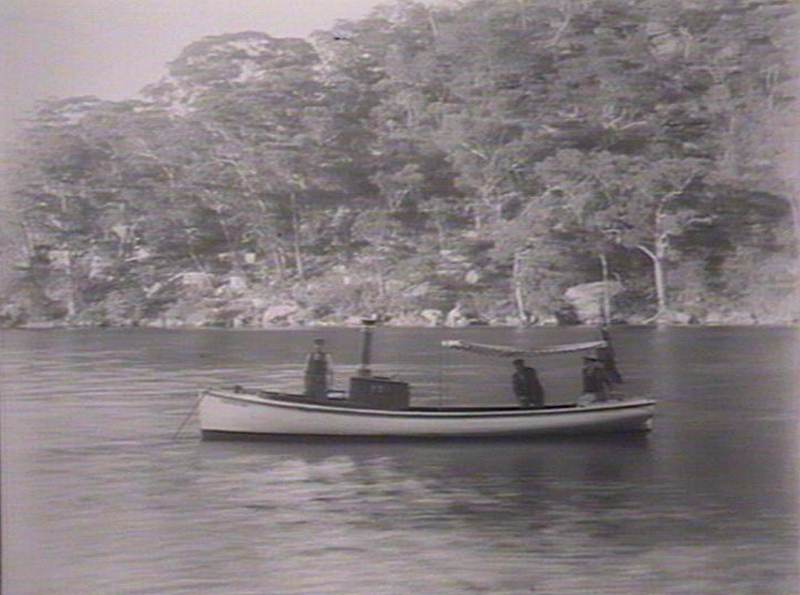
Trustees oil launch, Kuring-gai Bay, 1899. Image No.: d1_08775 and d1_08776, courtesy State Library of NSW
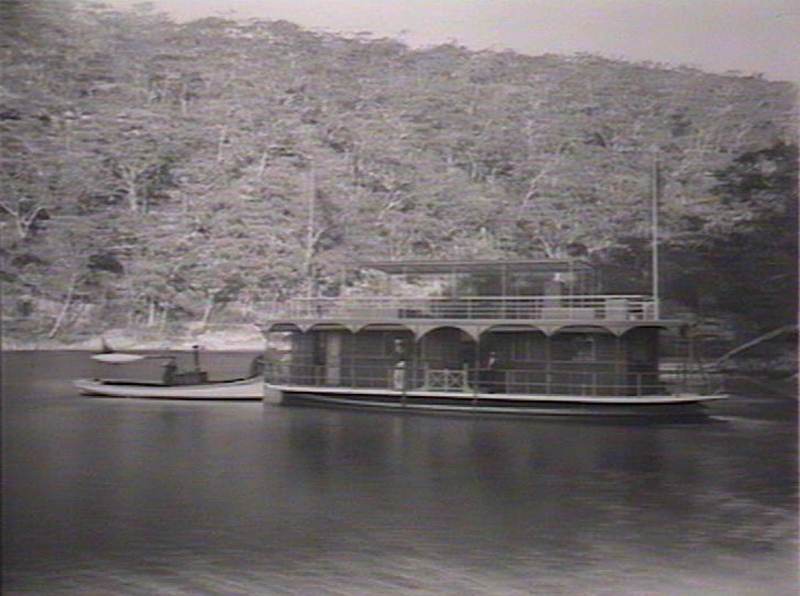
Another work which is being pushed forward is that of forming walking paths which skirt the edge of the different watercourses. Their cost of making is comparatively slight, and they enable the excursionist to wander over miles of otherwise inaccessible virgin tracts, and to enjoy delightful gems of scenery. Already several of these paths have been completed, but many more are needed. It is pointed out that a small expenditure in this direction would connect Coal and Candle Creek on the Cowan side with McCarr's Creek at Pittwater, or Refuge Bay with the Basin, and thus make these points within easy walking distance.
The work of protecting the flora is one of difficulty, and could be much assisted by the judicious construction of a little fencing so as to mark the points of egress from the Chase. In their endeavours to establish a native animal reserve the trustees meet with equal trouble, and point out that by the erection of a line of fencing from Duffy's wharf to the head of Smith's Creek some five or six thousand acres could be made absolutely secure for that purpose. Generally speaking it appears that a small expenditure would place Kuring-gai Chase in a fairway to accomplish all the aims for which it was intended. IN KURING-GAI CHASE. (1902, September 22). The Sydney Morning Herald (NSW : 1842 - 1954), p. 5. Retrieved from http://nla.gov.au/nla.news-article14506310
THE KURINGGAI CHASE LAUNCH.
With reference to the report of the burning of the launch and houseboat belonging to the trustees of the Kuringgai Chase, we have ascertained that the facts are as follows: The launch and houseboat were moored near each other about a mile from Bobbin Head, in Cowan Creek. The launch was undoubtedly set fire to wilfully, and the ropes which
attached it to the houseboat were burned. The house-boat was charred in places, but escaped any serious injury, while the launch drifted ashore on the high tide and burned itself out while it rested on the rocks. The launch is a total loss, and the fact is deplorable, inasmuch as it was of use in connection with the improvements being carried out in the Chose under the direction of the managing trustees. THE KURINGGAI CHASE LAUNCH. (1901, May 9). The Sydney Morning Herald (NSW : 1842 - 1954), p. 6. Retrieved from http://nla.gov.au/nla.news-article14383718
THE AUDACITY OF THE SWALLOW.
Dr. Richard Arthur, M.L.A., writes to "The Daily Telegraph" (Sydney).—"When visiting Pittwater the other day with the Premier and some other gentlemen, we had the opportunity of seeing a swallow's nest placed in an almost Incredible position. "The trustees of the Kurin-gai Chase have a launch driven by an oil engine, which is enclosed In a small glassed-in cabin. On the top of the lamp in this cabin two swallows have built their nest, which now contains two swallowettes, three days old.
"Mr. Willmott, who is in charge of the launch, informed us that he destroyed the nest twice. The launch was then laid up for a week, but a small port-hole was left open. When he again entered the cabin he found a fully-formed nest, which contained three eggs. The female bird stuck to the nest, and either ignored his presence, though his head, while he was cleaning the engine was within a few inches of her, or would make a pretence of flying at him.
"Now, when the launch goes on a trip, the parent birds perch themselves on the bow. If they leave the boat they will turn up some hours later, even though it has travelled five or six miles in the meantime, and fly straight into the cabin. Mr. Willmott believes that the swallows have chosen this extraordinary position for their nest to escape the iguanas. He is speculating how the parents will teach the young ones to fly." THE AUDACITY OF THE SWALLOW. (1906, December 15).The World's News (Sydney, NSW : 1901 - 1955), p. 4. Retrieved from http://nla.gov.au/nla.news-article128277180
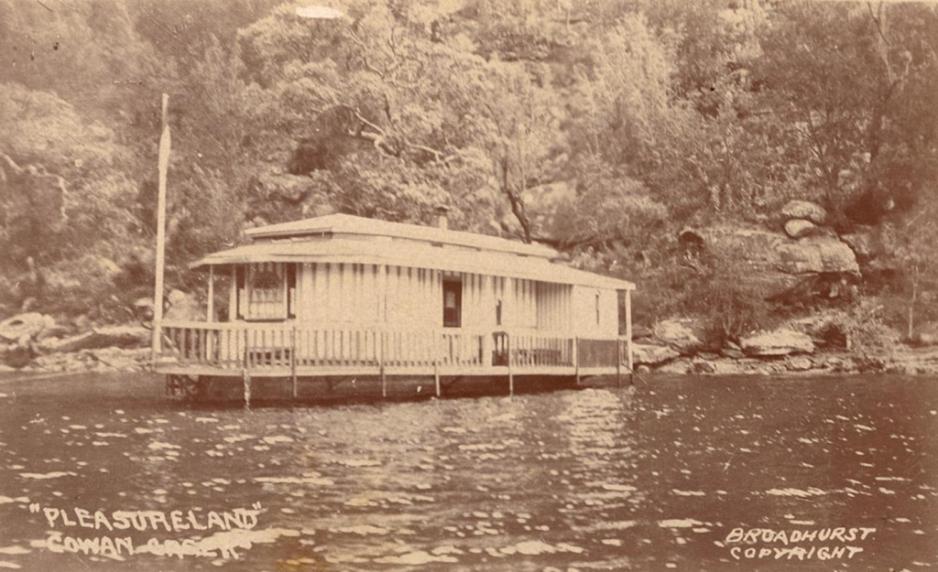
Windybanks Pleasureland houseboat, circa 1900. Image No.: a105189h, courtesy State Library of NSW.
Pittwater's Parallel Estuary - The Cowan 'Creek' - threads collected and collated by A J Guesdon, 2014.